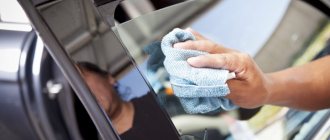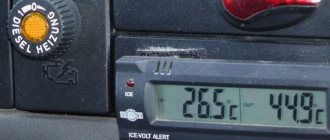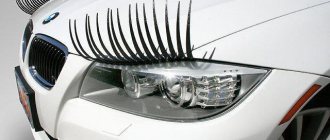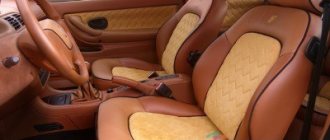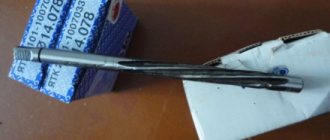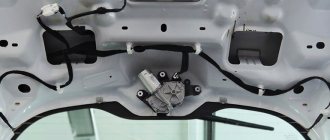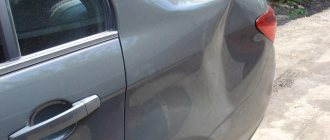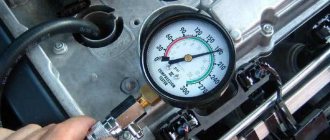In severe accidents, the car body becomes deformed. A faulty housing will affect fuel economy and handling. A body with broken geometry will not be able to protect passengers in the event of a repeat accident. A body repair bench is a necessary tool for car repair.
Types and features of slipways
There are a lot of types of slipways, and each of them belongs to a specific group:
- Floor bench for body repair: is a large-sized mobile system. Movement is carried out along laid rails. The use of a floor slipway is relevant for the restoration of truck and passenger bodies of any degree of deformation. The set for the floor stand includes clamps, a straightener with a pneumatic mechanism, and reinforced stands. Despite the size of such a device, it does not take up much space, and its simple space with rails can be used for other purposes, because their level is the same as the floor. The rectifier can operate in any direction, which facilitates the repair process. The average cost of such a product varies from 125 thousand to 360 thousand rubles.
- Platform slipway: comes complete with rails and access bridge. Equipped with a winch and a mobile unit for vehicles whose wheels do not function. “The support legs have a reliable hydraulic mechanism, which guarantees a long service life.”
Fastening beams have the ability to move structures weighing more than 20 tons in any direction. The platform slipway makes more accurate calculations and determines errors thanks to the telescopic scale. The cost of such a device is 300 thousand rubles or more. - Frame bench for body repair: compared to other types of restoration stands, it is highly ergonomic and economical in working space. In particular, this is caused by the presence of a car lift. The slipway securely fixes the machine and straightens it according to the specified parameters. Pressure on the body is exerted by the hydraulics of the power device. Due to the insufficiently strengthened leveling system, the frame jig cannot perform complex restoration work, but is useful for minor body damage. The cost of the device is 70 thousand rubles or more.
Frame slipway for quick repairs
The equipment has a standard configuration:
- Fixing elements for attaching the flange to the straightener.
- Fortified columns.
- Hydraulic pump.
- Pull-out mechanism with multiple fixation points.
- Clamps for body work.
- Reinforced chain.
The slipway for quick repairs is equipped with a reinforced flange grip, which ensures that there is no risk of the vehicle sliding off the platform. With this device you can easily correct minor impacts to the sides of the car, without necessarily securing the car to the floor.
The model provides the ability to limit the movement of rotating parts due to locking structures on hinges. The main column is smoothly adjustable in a vertical position in any direction of traction, which reduces the time of restoration work. The workflow goes as follows:
- Raising the car to the desired level and securing special blockers under the wheels.
- Placing the machine on the repair platform.
- Supply of clamps for flanging and fixation to the ramp.
- The reinforced column is installed in the desired location using a hinge.
The weight of this design does not exceed 400 kg, the tower can tilt 90 degrees.
Slipway for adjusting body geometry
Violation of body geometry often leads to a dangerous situation on the road
. The slightest deviation of the geometry from the norm causes such phenomena as skidding, poor cornering, etc. Any technical documentation indicates control points by which specialists determine the correct geometry of the car and, accordingly, the parameters of its distortion.
It is carried out using a slipway, which pulls it into place using a power mechanism. Do-it-yourself restoration of body geometry is carried out using factory equipment and a self-assembled device.
The features of the slipways include:
- The presence of 4 anchor posts on the platform, installed anywhere in the elongated groove.
- The traction force of the columns is up to 10 tons.
- Full lift ensures smooth adjustment of the entire platform.
- Availability of entrance ramps.
Do-it-yourself slipway for body repair
A slipway is complex repair equipment that requires professional skills, both in operating the device and in assembling it. The slipway is made with your own hands from standard devices:
- Metal profile 150 cm long with a section of 40x80 mm.
- A steel longitudinal profile with a section of 20x40 is suitable for support posts.
- The corners will be needed for welding to the posts.
- Welding machine.
- Fine thread bolts and nuts.
- Fasteners (best suited for foreign cars).
- Anti-corrosion epoxy primer.
- Powder paint, spray gun.
- M10 bolts.
- Hydraulic device with a thrust level of at least 4 tons.
- Powerful chain with hook.
To assemble a slipway you need drawings to do it right. Without them, problems and inconsistencies in parts may arise.
Drawings can be found on the Internet. The construction of the slipway elements proceeds as follows:
- Corners with holes for bolts need to be welded to the metal profile that serves as a transverse beam. You will get a stand with grips. If a slipway is required for one machine, then all holes must be made according to individual parameters.
- It is better to reinforce the longitudinal steel profile - racks - with corners. This is required to properly capture the thresholds of the car. The minimum height of the stand is 25 cm.
Before starting installation work it is necessary to paint. It will also work, but the first option is better and more reliable:
- All elements of the future slipway must be cleaned and degreased, and then made resistant to corrosion.
- After priming the car repair tool, you should wait until it dries completely.
After this, the installation process continues:
- It is recommended to fix all racks with M10 bolts. They serve well when working with hydraulics of any traction level.
- The resulting slipway must be placed in the workspace, taking into account the minimum parameters: a passenger car must fit freely on the stand, and there must be no foreign objects that interfere with the movement of the slipway.
- Finally, all that remains is to attach the chains and grips.
How to make a slipway with your own hands, you ask: drawings, materials, and auxiliary tools are freely available, so the work of assembling your own repair stand is within the power of every car owner. There would be a desire.
Do you want to know everything about car painting? Read more useful articles:
- . Have you tried painting it?
- . How to do it right.
- . What manufacturers are silent about.
It will not be possible to cope with straightening a car body without the use of special aids. One of the main devices for restoration of body geometry damaged as a result of an accident is a slipway. This device allows several tons of force to be applied to compress or stretch the body. In this case, a prerequisite is the reliable mounting of the car on a special frame: the result of the work will depend on this. If it is not possible to purchase such a design, it is possible to use a homemade slipway for body repair.
Stages of manufacturing a slipway
The most popular are platform or frame designs. This is due to the ease of their manufacture, compact dimensions and relatively large functionality. Finding suitable drawings on the Internet today is not difficult. The best option is to measure the finished factory slipway and focus on its design. The main requirement here is the dimensions, which must correspond to the area of the workshop or garage. The recommended dimensions of the slipway are 4.5 × 1.85 m. Externally, this is a structure where one frame is inserted into another.
Required tools and materials
You will need a welding machine, a hydraulic device, an angle grinder, a drill with drills, a spray gun or paint brushes. Materials you need to purchase:
- profile pipe 40×80 mm (calculate the length in accordance with the drawing, taking into account the jumpers) with a thickness of 4 mm;
- metal for making scarves (thickness 4 mm);
- clamping devices (you can buy factory ones, but if this is not possible, then how to make them yourself will be described below);
- bolts, nuts;
- primer;
- regular or powder paint.
Frame making
First, the outer frame is welded from the profile, then the inner frame is attached to the finished structure. It is necessary to boil from above and below, turning the structure over. Don't forget to use gusset reinforcements at the corners of the structure to increase its rigidity. If you have doubts about the strength of the frame, weld a couple of cross beams in the middle. When the frame is ready, legs must be attached to it from below to adjust the horizontal position of the device. To do this, you can use 15 cm long bolts and 24 cm nuts, which are welded at the corners of the structure. If you wish, install wheels instead of hardware - you will get a mobile slipway. This makes sense if you have a perfectly flat floor or if you place the structure on rails that are in a strictly horizontal position.
Devices for fastening the body to the slipway
If it is not possible to purchase ready-made clamping clamps, then you can make them yourself from railway platforms, through which the rails are attached to the sleepers. Cut each of them in half and weld metal onto the inside, which you can use a grinder to cut into diamonds. Leave the outer side as is, so that when installed on the car sills, their outer side is not damaged. Weld a 4 mm thick plate onto the inner part. This is necessary so that the clamping part evenly fixes the threshold and does not warp.
Making stands, or paws, and upper clamps
You will need steel 1 cm thick. Cut rectangles 200 mm wide and 350 mm long. Weld vertical posts 300 mm high to the resulting platforms; do not forget about the triangular reinforcing struts made of the same metal. To make upper clamps 200 - 250 mm long, it is best to use 1.5 cm thick fragments from KAMAZ springs. You need to burn holes in them for the mounting bolts.
Making a slipway with your own hands: frame design
You can make a slipway yourself; to do this, you should study videos and photos on the Internet, which describe the step-by-step work on its creation. The process of making a homemade device will not take much time and money. Of course, repair work requires hydraulics, which is not possible to produce at home. Therefore, let’s look at how you can make a slipway frame that is responsible for fixing the car. You need to start with a drawing, which you can create yourself, or download a photo on the Internet.
To manufacture the transverse beam, a metal profile is required, on which a stand with grips will subsequently be attached to fix the thresholds of the car. Threshold grips are made from metal corners in which holes are drilled for mounting bolts. Then the corners are welded to the beam. You need to make holes taking into account the car model. If you need to change the dimensions, you can simply drill additional holes in the beam. The minimum profile dimensions are section 40x80 mm and length 150 mm. Such parameters allow us to repair almost all types of passenger cars.
In order to make racks, you will need a longitudinal metal profile with a cross-section of 20x40 mm. The height of each rack should be 25 cm. To strengthen it, you need to weld gussets from the same profile. Corners are welded at the top to grip the thresholds of the car.
To ensure good adhesion, you can pre-notch or weld the nuts. Use bolts and nuts with fine threads as fasteners. Helpful advice: it is best to borrow fastening elements from foreign cars, where the bolts are much stronger and of better quality than in any store. It is better to fix the racks on the beam with M10 bolts: such fasteners allow you to work with hydraulics that develop a traction force of up to 4 tons.
The final stage of work
To protect against corrosion, you should create a reliable protective coating, because the device will be installed in a place of high humidity. To do this, after first cleaning all the structural elements, we cover it with a primer. The most reliable protection against rust will be provided by an epoxy primer, so it is better to use it. Without waiting for the primer to dry, apply paint with a spray bottle. (To make a homemade structure more presentable, that is, a factory look, you can apply black stripes to the frame after the paint has dried).
So, the homemade frame is almost ready. All that remains is to install it in the prepared place. You can make another similar device, but do not fix it to the floor, but attach it to a rotating column. By combining this design with the one described above, we get a mobile version.
In severe accidents, the car body becomes deformed. A faulty housing will affect fuel economy and handling. A body with broken geometry will not be able to protect passengers in the event of a repeat accident. A body repair bench is a necessary tool for car repair.
A body straightening bench is a device for carrying out body repairs. The stand is designed for straightening serious damage to a car, and is equipped with fasteners that allow you to stretch the body, as well as change the shape and size of some elements. The slipway is used to repair serious damage to the car body.
DIY making
Realizing that the slipway effectively replaces physical strength in stretching, Russian body repair enthusiasts came up with a homemade version of it.
The operating principle of standard slipway equipment is clear: a car is mounted on a frame. The main thing is reliable fixation, because the positive outcome of the case depends on it.
High-quality slipway equipment is not cheap. Often for this reason, many hobbyists decide to make this machine with their own hands.
First of all, making a slipway at home involves calculating the necessary components. A drawing is made and the required supply of materials is calculated. The base of the slipway is a tetrahedron made of an iron profile with a section of 50x50 or 70x40. As for the length, 200 cm is considered optimal, and the width should be equal to the wheelbase of the car.
A stiffener made of a similar material – a metal profile – is welded in the middle of the platform. Then, as mentioned above, a calculation is carried out, and the amount of the required metal is ordered at a special base or found in another way.
The slipway is also equipped with good hydraulics. In this case, a kit that can withstand a load of up to 10 tons is suitable.
Depending on what type of slipway it will be (mobile or stationary), it is equipped accordingly. A stationary slipway should not move, and therefore is not equipped with wheels. A mobile bench, on the contrary, in addition to wheels, must also be equipped with a device for storing the machine in a vertical position.
The assembly process is carried out using welding. This means that welding skills are required.
Here's what to do:
- Assemble a rectangle from the profile, and then reinforce it in the middle with additional material.
Note. A homemade slipway can be assembled at the request of the future owner. It is likely that he will want to strengthen the machine longitudinally or transversely. Therefore, it is not possible to give definitive advice on this matter.
- Heights are welded into the corners of the machine to prevent the car from possibly rolling off the slipway;
- Clamps are installed on the longitudinal sides of the frame;
- A power rack is installed in the shape of the letter “L”, which can easily move and be secured anywhere in the frame.
All that remains is to paint the homemade machine, equip it with components for repair and start using it.
Video of a homemade body repair installation
You can learn more about the operation of the body slipway and its capabilities from video and photo materials, as well as from other publications on our website.
In severe accidents, the car body becomes deformed. A faulty housing will affect fuel economy and handling. A body with broken geometry will not be able to protect passengers in the event of a repeat accident. A body repair bench is a necessary tool for car repair.
A body straightening bench is a device for carrying out body repairs. The stand is designed for straightening serious damage to a car, and is equipped with fasteners that allow you to stretch the body, as well as change the shape and size of some elements. The slipway is used to repair serious damage to the car body.
Types of slipways
All types of slipways have an identical principle of operation. To eliminate body deformation, it is fixed to one or more areas that need straightening and straightening. Next, the master, using an exhaust device, applies force and straightens the damaged parts of the body.
Simple stocks intended for body repairs are equipped with one exhaust device. Complex devices have several exhaust mechanisms.
There are 4 types of devices: floor, rolling, frame and platform.
Rolling tackles
The rolling berth is used for body repairs of various types of cars. It is equipped with devices that allow you to secure the car without flanging the sills. Rolling stocks are convenient to use in confined spaces. Thanks to this, the device is used in garage conditions.
Rolling equipment cannot be used if distortions occur and the body geometry changes.
Floor-standing
A do-it-yourself floor stand for body repair is a compact and effective equipment for restoring a car body in a garage or workshop. If there is no need to use an exhaust mechanism, then the rails are used for other purposes.
Frame
The frame slipway belongs to the professional variety of exhaust mechanisms. The main difference from other types is that frame devices have a complex design.
The extraction mechanism allows you to repair different car models. The machine is fixed on a frame, which is highly durable. With the help of force directed in different directions, body deformations of mild and moderate severity are pulled out.
To save space in a workshop or garage, as well as to facilitate the process of restoring the car body, purchase stands for body repair, equipped with a lift.
Platform
The platform slipway for body repair is a full-fledged professional equipment. Devices of this type are used to repair damage to the body of any car, including frame SUVs.
The design of the pulling mechanism consists of special rails and an entry bridge-base. The car drives into it on its own, or it is pulled there if the car is not moving. The platform is equipped with various devices and fastening mechanisms that securely secure the vehicle to the slipway.
Platform devices have hydraulic metal stands, a winch, power and retractable blocks. The beams of the device allow you to effortlessly move heavy structures in any direction. The platform straightening stand has a telescopic scale, with the help of which precise calculations and measurements are carried out.
The disadvantages of the platform exhaust mechanism include large dimensions and high cost of the equipment. It is used in large car maintenance services.
Types of slipways and their main differences
There are 4 types of design:
- Floor-standing. Standard rail mounted design.
- Roll-on. Small in size. Such structures are stored in a garage or workshop.
- Frame. Structures on chains designed for complete repairs and lifting the machine to a height.
- Platform. Designed for professional repairs. Suitable for large machines.
Floor structures
The floor slipway is also called stationary. Its difference is that there are rails on the floor that allow you to move the mechanisms. With their help it is easy to carry out body work.
The stationary slipway is convenient thanks to retractable mechanisms.
Floor structures have 3 advantages:
- They take up little space.
- They cost less than other slipways.
- Fast installation of transport.
The disadvantage is the complexity of installation of the structure.
Roll-up
A rolling slipway is a slipway that is used for light repair work if there is no full-fledged slipway or its use is impossible for some reason. The difference is that the rolling slipway is small in size - it is not necessary to roll the car up to it. You can bring the rolling slipway to the car.
This design has advantages:
- It is customizable for different types of cars.
- Possibility of equipping the device with hydraulics.
- The clamp fastening design has no analogues.
- Can be used with most types of machines.
- Compact size.
The disadvantage is that it is impossible to carry out complex work involving large distortions.
Frame
A distinctive feature of frame structures is the use of the frame as a base. The car is secured with chains. Most often this design is used for minor repairs. But, at the same time, the structure of frame stocks is more complex than others. They are equipped with grippers that allow you to fix the car body in the required position or even lift it to a certain height.
Platform models
The platform model is very similar to the trestle structure. It allows you to pull the car body in any direction. A lot of different equipment can be installed on the slipway platform. Pulling on a platform is very convenient, and the functionality is enough to make professional repairs right in the garage.
Homemade equipment
Creating a homemade slipway for straightening the body will save money, since they are expensive. When designing, you should take into account the dimensions of the future device for car repair and create a drawing of the device. You can order it from specialists, or find a ready-made one on the Internet. Depending on the type of exhaust mechanism, the set of tools and materials that will be needed differs.
Manufacturing of a mobile slipway
To make a mobile body straightening device yourself you will need:
- From a profile more than 4 mm thick, you need to create a frame with dimensions twice the dimensions of the machine.
- The structure is strengthened by cross members and corner elements. The crossbars will be used to secure the car. Exhaust mechanisms are also attached to them.
- To make the structure mobile, four wheels are attached to the bottom.
- To be able to lift the car onto the frame, a gangway is constructed. On one side they will have a special plug, and on the other a removable section necessary for lifting the vehicle.
- The structure is equipped with a bench vice or special clamps. They are needed to securely fix the machine.
To ensure that the structure lasts a long time, it is coated with a layer of primer and painted.
Manufacturing of a stationary slipway
When constructing a straightening stand with your own hands, the channel is concreted and also reinforced with cross members of a rigid structure. The optimal material for creating a “hospital” is a metal profile with a section of 40 by 80 mm. The length is determined depending on the dimensions of the car.
Next, four fasteners are installed around the perimeter of the frame, which are intended for a vice that clamps the machine. They move perpendicular to the channel, thanks to which damage of any size can be repaired. The car is placed on a stand for body repair using a jack: first the front part of the car is lifted, then the rear. In a garage or auto repair shop, you will need to install special eyes necessary for attaching the chain.
To facilitate the process of lifting the car, use a homemade lift. It is done using a winch and a special platform.
The slipway is the necessary equipment for do-it-yourself body repair. The device eliminates damage to the car body. When restoring the machine body yourself, an exhaust mechanism is also necessary.
The car owner is usually forced to make a slipway with his own hands by the non-standard design of his garage or by the lack of funds to purchase standard devices intended for body straightening work.
The immediate purpose of the slipway is to restore the geometry of the body damaged as a result of a traffic accident. A bench for body repair allows you to apply several tons of force to it, resulting in compression or, conversely, stretching of the body structure.
Various types of stocks and preparation for making a simple device with your own hands
Since this device is very powerful, in order to avoid accidents during body work, it is necessary to ensure that it is securely mounted on a specially made frame. The frame slipway is the most common device for self-restoring body geometry.
There are three types of stocks, and each can develop a force of up to ten tons, which is quite enough for straightening almost any body. The following types of slipways are distinguished:
- Frame slipway. Its design necessarily includes a frame made of metal. At the same time, special clamps are required to fix the car on it. The directly deformed area is straightened using a chain connected to a power device. In addition, for the correct operation of such a device, it is necessary to use a lift.
- Platform slipway. This straightening device is more versatile and therefore applicable for a wider range of body repair work. Here, all operations are performed on a special platform with a system of clamps and fastenings mounted on it.
- Floor slipway. This is an exclusively professional device that moves along rails embedded in the floor of the garage box. This slipway even allows for the repair of trucks, as it has a reliable design and impressive dimensions.
Each of these types of slipways has its own advantages and disadvantages.
Making a slipway
The frame is assembled by welding. That is, skills in working with a welding machine are required.
Stages of work:
- First of all, a rectangle is assembled from a metal profile of the estimated length and width; exactly in the middle it needs to be reinforced with an additional profile. The frame is assembled as the future owner of the slipway deems necessary. He may want to further strengthen the longitudinal sides of the frame, perhaps the transverse ones. There is no definite principled position on this issue.
- To increase the stability of the car on the slipway, it is necessary to weld heights in its corners that will prevent the car from possibly sliding off.
- The next stage is installing fasteners on the longitudinal sides of the frame. Fasteners are clamps with jaws that are required to securely fix the vehicle frame when loads are applied to it. There cannot be a strict location for fixing the fasteners; they must be able to move along the entire length of the frame. Making clamps with your own hands is also possible, but if they are on sale, then there is little point in this, since a homemade clamp will cost about the same as a factory one.
- Next comes the installation of the power rack. The power rack is a device in the shape of an inverted letter L, which must also move throughout the frame and be securely fixed in any place. You can make not one, but two power racks.
- Giving the slipway an aesthetic appearance. This stage consists of ordinary painting of the slipway.
- Well, at the end of the work, the homemade slipway is equipped with those repair devices for which it was created: hooks, chains, hydraulics.
Carrying out preparatory work
Before making a slipway, it will be necessary to carry out a number of preparatory work. So, it is worth determining in advance what kind of work will be performed on it, and what car models can be repaired with its help. For example, if you decide to open a body shop, then you will need a platform device, but for small household work, a frame unit is quite suitable.
Having decided on the type of slipway, you should prepare the floor of the room where it will be installed. Thus, the frame structure will require deepening of the fasteners for it into the floor, as well as securing them with cement mortar. But the platform can be completely installed in the garage without attaching it to the floor, since its weight will allow the necessary body work to be carried out.
Making a simple frame device
It is easiest to make a frame slipway with your own hands, since this is the simplest and most common design for non-professional use. To carry out body work, in any case, you will need hydraulics, which cannot be manufactured independently, so the manufacture of a slipway will be limited only to the design and installation of the frame.
Since this part is directly responsible for securing the car, it is necessary to carefully approach its installation. To do this, it is worth preparing drawings in advance; you can draw them yourself if you have such experience.
A metal profile is usually used as the material for the frame. A stand with grips is attached to it, which will fix the thresholds of the car. The thresholds, in turn, are welded from metal corners and installed on the beams using bolts.
After installation, these elements are also strengthened by welding. The dimensions of the metal profile are determined based on the fact that the minimum dimensions of its cross-section should be 40x80 mm, and its length - 150 mm. A profile of this size will be quite sufficient for straightening the body of most passenger cars.
A homemade slipway requires the manufacture of racks. Typically, a metal profile with a cross-section of 20x40 mm is used for this, and their height should not be less than 25 cm. Gussets are welded onto the finished racks, and at the top - corners that grip the car sills.
Step-by-step construction instructions
The construction of any home-made structures begins with the design stage. You need to make a slipway that is convenient to use. It is important that it does not take up too much space, blocking free movement.
The second point is always the creation of the structure's frame. The last point is to install fasteners and tightening devices yourself.
Drawings and dimensions
First you need to make suitable drawings. Ready-made options can be found below. The markings are made according to the dimensions of the vehicle. Afterwards the stage of preparation and selection of tools and materials begins. We will also need to make a mounting system large enough to fit our vehicle. It would be nice to cook it with the ability to change the height.
- Once all the drawings are ready and the materials have been selected, you can start working. First you will have to remove moisture from the materials and coat them with a primer. You can paint them right away, or you can leave this step for last.
- Now weld the metal corners to the base profile.
- Weld the profile (this will be the stand). It is secured with bolts.
- Now the chains, hooks and retractable devices are welded.
Frame making
The frame is responsible for fixing the car. Therefore, you need to be careful when creating it.
- Before creating the frame, you need to create the outer frame. It is to this that the frame will be mounted.
- A metal profile is suitable as a material. A stand and grips are attached to it (they are needed to fix the car threshold).
- Now the thresholds are being made. They are created from metal corners.
- Thresholds are installed on beams and secured with bolts.
- After installation, all elements will have to be secured by welding.
Fastening the body to the slipway
Clamps are required for fastening. If you can't buy them, make your own. You will need railway platforms (what the rails are attached to the sleepers). Each of the platforms is cut in half, and metal is welded onto the inside. It is cut into diamonds using a grinder.
You don't need to do anything to the outside. A plate 4 millimeters thick is also welded to the inside. It is important that the clamping device fixes the threshold and does not bend during use.
Installation of rack and pulling devices
Factory hydraulic attachments are suitable for racks and devices. If they cannot be purchased, a homemade mechanism will do. The power of the device should be from 1 to 2 tons. To attach the pulling devices, you need a pad. It is made from a channel and installed in the frame of the slipway. To place the tightening mechanism and chains in any place, it is necessary to make holes in the frame along the entire slipway.
If the stand is made independently, it is recommended to use a tower device. It is heavy, but the restoration of the car will be uniform.
Making a slipway is not that difficult. If you have basic knowledge of construction, you can easily do everything yourself. The main thing is to choose the right material and make the right drawings.
We are talking about a device used when performing car body repair work. Such equipment allows you to correct its serious damage, change the size and configuration of some elements. The desired result is achieved through the use of multidirectional forces acting on a well-secured machine. Factory equipment is quite expensive, but it is much cheaper to make a bench for body repair yourself.
Completion of manufacturing work
When making a slipway with your own hands, you need to remember that for better grip you will need to make special notches or weld nuts on the racks. To fasten frame elements, it is necessary to use nuts and bolts with fine threads. At the same time, experienced car enthusiasts advise taking such fasteners from repair kits from foreign cars.
When working with hydraulics with a capacity of about four tons, it is worth using M10 bolts. They allow you to clearly fix the racks on the beam and subsequently withstand the specified load.
After installing the device, be sure to paint it to protect it from corrosion, since it will be installed in a room with high humidity. To do this, you need to clean the metal from rust and coat it with a primer. After this, you should paint the frame using a spray gun.
After painting, the frame is mounted at the place of use. The installation site must be prepared in advance, and if you plan to carry out a wider range of body work, it makes sense to manufacture and install another homemade slipway mounted on a rotary column.
If a more functional slipway is required, you can carefully study the design of industrial samples and try to replicate it yourself. Or you can purchase ready-made equipment from body shops that sell old stocks.
Servicing a passenger car is a very expensive business: you need to change consumables, carry out maintenance, and also have to periodically repair various parts of the car. It is much more profitable to improve your car, change parts and repair anything on your own. Therefore, your garage should have the necessary equipment and tools. Among such devices, it occupies an important place. You can make this device yourself.
Platform slipway
There are three types of slipways: frame, platform and floor. There are also different devices according to the type of movement: rolling and mobile.
Why is a frame slipway convenient?
There are 3 main types of slipways. These are frame, platform and floor devices. Each type has its own advantages and disadvantages. The platform slipway is very convenient for large vehicles. This device is placed on the ground, a car is driven on top of it and secured using special clamps on all sides. But here it is necessary to understand that the efforts that need to be made to repair the body can be both small and significant.
The floor slipway also has rails on which special exhaust devices for the body can ride. In fact, this is very convenient, because you can get to even the most inaccessible place and fix a very deep dent in the body.
But the most common is the frame slipway. Its structure is very similar to the floor one. Only you need to put the body on it, freed from the chassis. Using a special chain with a lever, the process of leveling even a very deformed body is carried out.
It is frame devices that are the best option for a garage. At the same time, making such a slipway with your own hands will not cause any particular difficulties for a man. It’s not even necessary to use complex drawings. It will only be enough to measure the space in the garage where such a device can be installed.
In terms of cost, even the manufacture of one frame slipway may turn out to be cheaper than repairing the body at a service station.
Different types of slipways
Frame type devices are made of a metal profile frame. The work is performed in a fairly simple sequence:
- clamping mechanisms that secure the car;
- a chain connected to the power mechanisms is attached to the damaged area of the machine;
- Using a slipway, the area is stretched out and given its original shape.
In order to safely load a car onto a frame-type structure, you need a lifting device. The frame slipway allows you to carry out various types of body repairs, but for complex work it is an unreliable design.
The platform slipway is used for the most complex body repairs. The metal platform is equipped with a complex system of fastenings and clamps. She also has a scissor lift and towers that perform force manipulation. Such platform equipment is considered universal. It makes it possible to pull the damaged fragment in all possible directions to return the correct shape. Since the device has various mechanisms and all kinds of fastenings, it is possible to carry out different types of car repairs. But the disadvantage of this design is the huge dimensions of the device.
Slipway design
The floor stand is most often used in the professional field of auto repair. Movement occurs on rails. The package includes:
- system of fasteners, clamps;
- metal racks;
- pneumatic rectifiers.
This type of device is suitable for repairing cars and trucks. In addition, this device can be used to repair cars of any level of damage. This equipment is very durable and reliable, as it has a large number of components.
